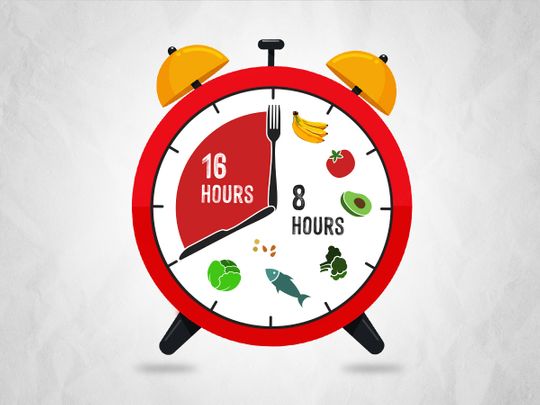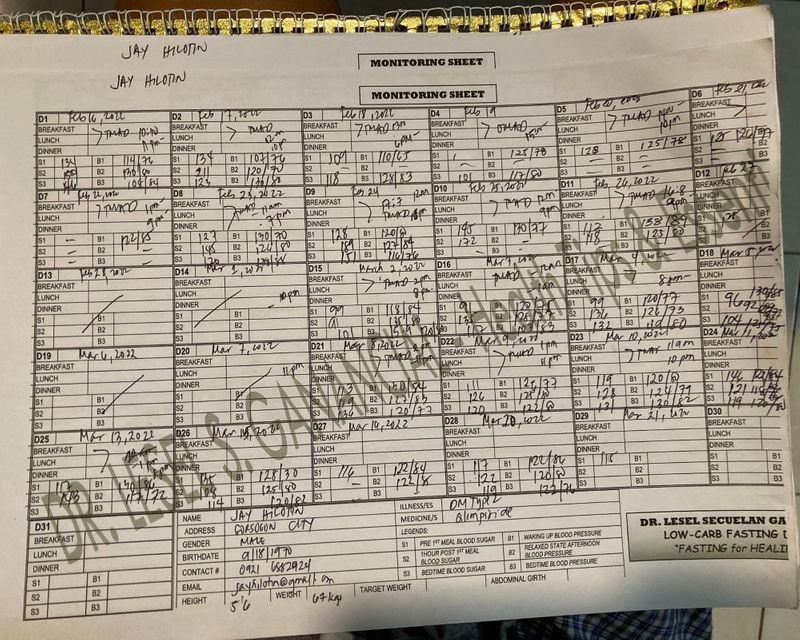(Note: This is not medical advice. Please consult your physician if you decide to enter into any diet or exercise regimen.)
Fear, they say, is a powerful motivator. It creates a strong need to move away from that state of fear, towards our “comfort zone”.
I was diagnosed with prediabetes (then diabetes) 8 years ago. During that time, I saw at least 3 different doctors. Among others, they advised me to go slow with carbohydrates (rice, bread, pasta, etc), to exercise regularly. I was relatively younger then and I had no shortage of excuses. I was trigger happy with my cravings.
Fear factor
Since 2014 I had been taking metformin, the first line medication for type 2 diabetes. I thought I would just keep going, hoping my condition would go away.
My parents were diabetics. The disease did not disappear. Both died of “comorbidities” that accompany this disease (father in 2015 and mother in 2021).
Statistically, my siblings (I have three, I’m the third child) and I face a 50% risk of genes being passed on. Our oldest son, Chris, is now taking injectables to keep his high blood sugar under control.
We all saw our parents go through a lot of pain and discomfort due to the complications of diabetes, in addition to the difficulties of old age.
Overweight: Doctors’ advice is ignored
The idea of falling with a similar affliction is a constant. So I religiously take (or took) my medications.
For most of my adult life, I was at least 10kg overweight. Doctors recommended a “lifestyle change”, ie weight loss, less carbohydrates, more vegetables; Less sweets, more exercise.
I discarded all that, I considered myself an exception to the rule. Now, the exceptionalism has disappeared. I was starting to feel lethargic, moody, unable to lose weight, had sugar cravings, skin breakouts, even brain fog.
My posture changed from a feeling of invincibility to that of an object of mercy in the face of impending wrath. Potentially from the same disease that killed my parents.
‘Diabetes corner’ in the house
As an Asian, I grew up eating anything with rice: rice with chocolates, rice with fries, rice with meat/fish, rice with coconuts. Rice with rice.
“Suman lehiya”, a local Filipino delicacy made of sticky rice with sticky coconut milk coated with sugar and vanilla herb extract (pandan), is a fixture in our house (usually an extra table) on special occasions. It was my mother’s favorite dish.
In the eight years I’ve been on blood sugar-lowering medication, I’ve never given much thought to my weight problem, or to doing anything radically different than what I’m used to.
I am 168 cm tall, the ideal average weight is 63.5 kg. I have always weighed around 75 kg or more. There was an internal dialogue: “I feel good with this weight.”
partner power
How did I decide to lose weight? The journey from a high-carb, anything-goes lifestyle to a low-carb intermittent fasting regimen kind of forced itself on me.
One key trigger: health insurance. My wife looked for health insurance last year. Most of the agents turned me down right away, after she declared my “pre-existing” condition.
That episode made me feel like an outcast, dirty, a social drag. Finally, one guy offered “global coverage,” for what I thought was a huge premium, the equivalent of $2,000 a year.
After giving birth to our third child, my wife Tweet had tipped the scales at 90kg (although her ideal body weight should be 65kg or less). Since 2018, she has been prescribed four “maintenance” medications (300 tablets each) after an examination at a local hospital. Nothing seemed to work.
Image credit: Facebook | Tweet Hilotina
Given the insurance rejections and the worry of getting sick and having young children, I thought it was time to face the music. Desperate times call for desperate measures.
Training
After giving birth to our third child, my wife Tweet had tipped the scales at 90kg (although her ideal body weight should be 65kg or less). Since 2018, she has been prescribed four “maintenance” medications (300 tablets each) after an examination at a local hospital. Nothing seemed to work.
This led us to look for a low carb workout. We found Dr. Josephine Chua Rojo and Dr. Lesel Ganancial, our intermittent fasting mentor. We initially track your live sessions on social media, then sign up for one-on-one online training, after you pay fees (total about $100).
Earlier this year, my wife also signed me up for online counseling with a low-carb doctor. This follow-up sheet had to be filled in constantly, during those 30 days. I’ve found that the hardest part is adopting this lifestyle, especially when no one is looking or checking.
Part of breaking unhealthy eating habits is closely monitoring our food intake and finger pricks daily, for at least 30 days. Is not easy. Eating habits are one of the hardest habits to break, I found.
It played out like a slow-motion movie, until it became routine. They say that it takes at least 21 days of daily practice for something to become a habit.
THE 21/90 RULE
■ A popular method for developing habits is what behaviorists call the “21/90 Rule.”
■ The rule is simple: Commit to a personal or professional goal for 21 days in a row.
■ After three weeks, pursuing that goal should have become a habit.
holistic approach
Understanding is key. Proponents of this lifestyle push for a “holistic approach,” focusing on physical and mental health and well-being. Some low carb sessions steeped us in cell biology and biochemistry, touching on the basics of hormone functions, metabolism, enzymes, toxicity, gluconeogenesis, and glycogenolysis.
These terms were once totally foreign to me. Further reading led me to Science Direct, which published a 2018 study suggesting that even so-called “digestible carbohydrates” are more toxic than lipids (fats).
Carbotoxicity
■ Going into overdrive with carbohydrates can cause blood sugar levels to spike. This causes your body to produce more insulin, a hormone produced by the pancreas that controls the amount of glucose in the bloodstream.
■ Carbohydrates range from digestible polysaccharides to refined sugars that collectively cause deleterious effects on human health, a phenomenon known as “carbotoxicity.”
■ This condition tells your cells to store the extra glucose as fat. Over time, this can be unhealthy, especially if you’re already tipping the scales above your ideal weight, which then leads to diabetes and other related health problems.
What’s behind someone’s food cravings? I discovered that an imbalance of hormones, such as leptin and serotonin, could lead to a downward madness with cravings.
Why does fasting work when combined with a low carb diet?
I’ve found that fasting is easier when you’re low carb. They support each other. More than a vicious circle, it is a virtuous one. It favors the adaptation of fat. It does this by upregulating your fat-burning mitochondria, stimulating the creation of new mitochondria, and reducing your reliance on sugar.
glycogenolysis
■ Glycogenolysis occurs when the body, which prefers glucose as an energy source, needs energy.
■ Glycogen previously stored by the liver is broken down into glucose and dispersed throughout the body.
In the low carb community, we were introduced to the list of “safe”, “caution” and “dangerous” foods.
We start with a daily 12-hour fast, progressing to 14, then 16, then 18 hours, drinking only liquids (water, unsweetened tea, or unsweetened coffee) during the fasting window, and then we stick to “safe.” , bass. carbohydrate foods during the feeding window.
Testimonials from people who have done it before us were also eye-opening.
Image Credit: Seyyed dela Llata | Source: Josefina Chua Rojo
glyconeogenesis
■ Gluconeogenesis is the synthesis of glycogen without using glucose or other carbohydrates, but rather substances such as proteins and fats.
■ An example: the conversion of lactic acid to glycogen in the liver. This is why glucose is so important that the body produces it, even without carbohydrates or sweets in our diet.
What doctors from the United Arab Emirates said
Interviews with doctors in the United Arab Emirates who practice low-carb intermittent fasting further reinforced this.
In my younger years, I was a great fan of fruit concentrates and desserts, mixing bitter chocolates with sweets, in a mistaken idea of reducing the harmful effects of sugar.
In the United Arab Emirates, where I lived for 20 years, the wide availability and affordability of fruits: watermelon from Iran, rock melon from Honduras, kiwis from New Zealand and mangoes from Pakistan/India, local dates and all sorts of foods from different parts of the world—were too convincing.
Then it hit me: there is a reason fasting works. For centuries and millennia, humans have survived drought and lack of food for days, if not months. However, they have adapted their body and mind through this cycle. It’s counterintuitive, but fasting sharpens the mind, a physiological condition that is key to survival (where to find the next meal?) among early men.
There is a downside to overabundance. The easy availability of food in general, and carbohydrates in particular, is a modern phenomenon, thanks to transcontinental flights and transoceanic supertankers.
Now some people (including colleagues at work and my grandmother’s 93-year-old sister) are expressing concern (or horror) and exclaiming why I’ve lost “so much” weight.
Part of breaking unhealthy eating habits is closely monitoring food intake, reducing carbohydrates, finger pricking, for at least 30 days, and intermittent fasting.
Image Credit: Jay Hilotin | Gulf News
But I never felt better: now I sleep better. Gone are the upset stomachs, bloating and constipation, sugar cravings, skin breakouts. Now, my blood sugar level is slowly returning to normal, without taking medication. I haven’t arrived yet, but I trust I will arrive on time. (I’ll update you here, when I do.)
The furthest thing from my mind was a low-carb, intermittent fasting lifestyle. The desperation that drove me to it. and fear. Perhaps love.
Even with training and tracking, our journey hasn’t been a perfect straight line of adherence. We allow ourselves to “fail”, sometimes, but not every day.
And it’s never too late to choose a healthier, low-carb, intermittent fasting, and purposeful life.



